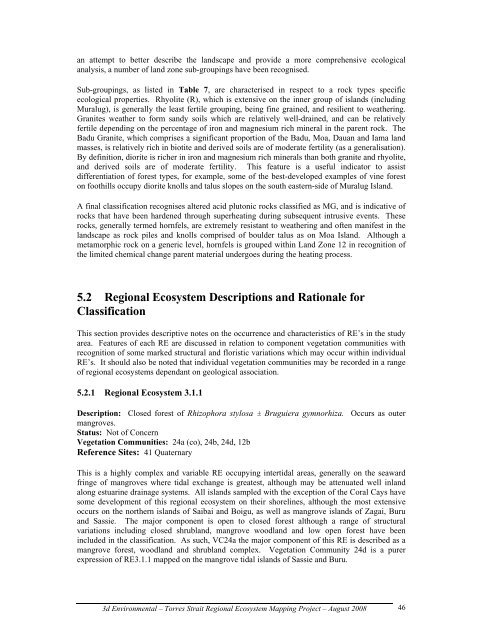Appendix 2 - Vegetation Communities and Regional Ecosystems
Appendix 2 - Vegetation Communities and Regional Ecosystems
Appendix 2 - Vegetation Communities and Regional Ecosystems
You also want an ePaper? Increase the reach of your titles
YUMPU automatically turns print PDFs into web optimized ePapers that Google loves.
an attempt to better describe the l<strong>and</strong>scape <strong>and</strong> provide a more comprehensive ecological<br />
analysis, a number of l<strong>and</strong> zone sub-groupings have been recognised.<br />
Sub-groupings, as listed in Table 7, are characterised in respect to a rock types specific<br />
ecological properties. Rhyolite (R), which is extensive on the inner group of isl<strong>and</strong>s (including<br />
Muralug), is generally the least fertile grouping, being fine grained, <strong>and</strong> resilient to weathering.<br />
Granites weather to form s<strong>and</strong>y soils which are relatively well-drained, <strong>and</strong> can be relatively<br />
fertile depending on the percentage of iron <strong>and</strong> magnesium rich mineral in the parent rock. The<br />
Badu Granite, which comprises a significant proportion of the Badu, Moa, Dauan <strong>and</strong> Iama l<strong>and</strong><br />
masses, is relatively rich in biotite <strong>and</strong> derived soils are of moderate fertility (as a generalisation).<br />
By definition, diorite is richer in iron <strong>and</strong> magnesium rich minerals than both granite <strong>and</strong> rhyolite,<br />
<strong>and</strong> derived soils are of moderate fertility. This feature is a useful indicator to assist<br />
differentiation of forest types, for example, some of the best-developed examples of vine forest<br />
on foothills occupy diorite knolls <strong>and</strong> talus slopes on the south eastern-side of Muralug Isl<strong>and</strong>.<br />
A final classification recognises altered acid plutonic rocks classified as MG, <strong>and</strong> is indicative of<br />
rocks that have been hardened through superheating during subsequent intrusive events. These<br />
rocks, generally termed hornfels, are extremely resistant to weathering <strong>and</strong> often manifest in the<br />
l<strong>and</strong>scape as rock piles <strong>and</strong> knolls comprised of boulder talus as on Moa Isl<strong>and</strong>. Although a<br />
metamorphic rock on a generic level, hornfels is grouped within L<strong>and</strong> Zone 12 in recognition of<br />
the limited chemical change parent material undergoes during the heating process.<br />
5.2 <strong>Regional</strong> Ecosystem Descriptions <strong>and</strong> Rationale for<br />
Classification<br />
This section provides descriptive notes on the occurrence <strong>and</strong> characteristics of RE’s in the study<br />
area. Features of each RE are discussed in relation to component vegetation communities with<br />
recognition of some marked structural <strong>and</strong> floristic variations which may occur within individual<br />
RE’s. It should also be noted that individual vegetation communities may be recorded in a range<br />
of regional ecosystems dependant on geological association.<br />
5.2.1 <strong>Regional</strong> Ecosystem 3.1.1<br />
Description: Closed forest of Rhizophora stylosa ± Bruguiera gymnorhiza. Occurs as outer<br />
mangroves.<br />
Status: Not of Concern<br />
<strong>Vegetation</strong> <strong>Communities</strong>: 24a (co), 24b, 24d, 12b<br />
Reference Sites: 41 Quaternary<br />
This is a highly complex <strong>and</strong> variable RE occupying intertidal areas, generally on the seaward<br />
fringe of mangroves where tidal exchange is greatest, although may be attenuated well inl<strong>and</strong><br />
along estuarine drainage systems. All isl<strong>and</strong>s sampled with the exception of the Coral Cays have<br />
some development of this regional ecosystem on their shorelines, although the most extensive<br />
occurs on the northern isl<strong>and</strong>s of Saibai <strong>and</strong> Boigu, as well as mangrove isl<strong>and</strong>s of Zagai, Buru<br />
<strong>and</strong> Sassie. The major component is open to closed forest although a range of structural<br />
variations including closed shrubl<strong>and</strong>, mangrove woodl<strong>and</strong> <strong>and</strong> low open forest have been<br />
included in the classification. As such, VC24a the major component of this RE is described as a<br />
mangrove forest, woodl<strong>and</strong> <strong>and</strong> shrubl<strong>and</strong> complex. <strong>Vegetation</strong> Community 24d is a purer<br />
expression of RE3.1.1 mapped on the mangrove tidal isl<strong>and</strong>s of Sassie <strong>and</strong> Buru.<br />
3d Environmental – Torres Strait <strong>Regional</strong> Ecosystem Mapping Project – August 2008<br />
46


